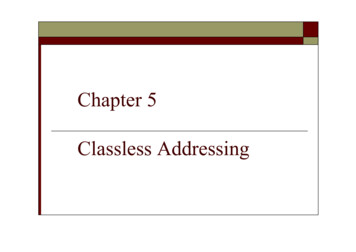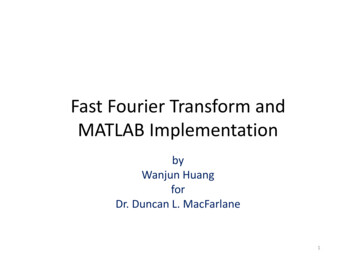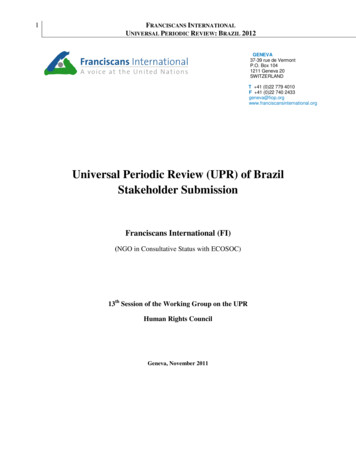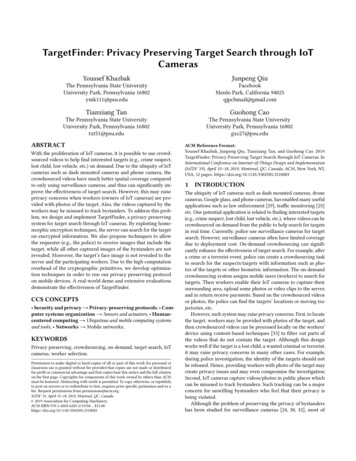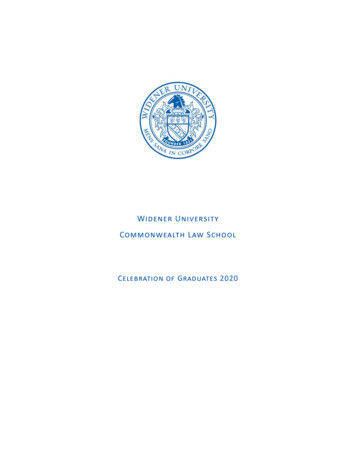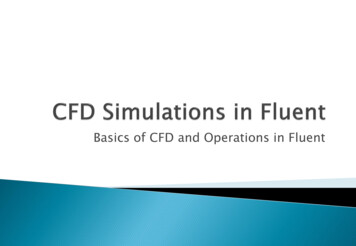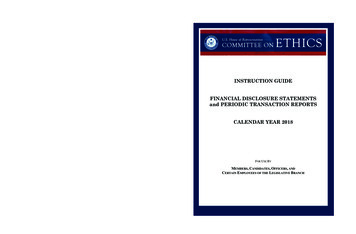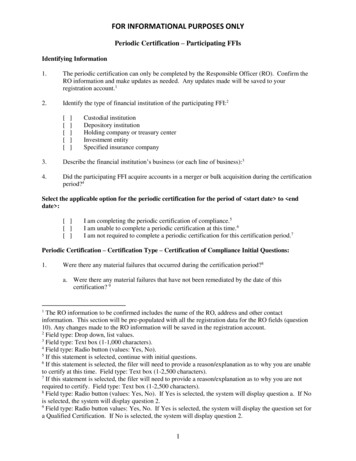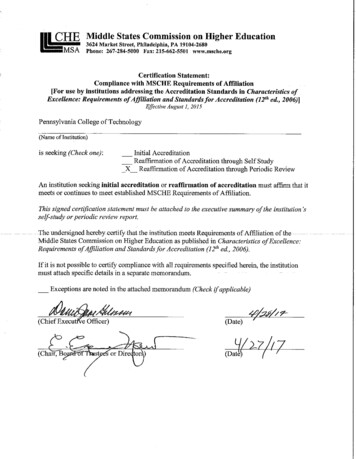
Transcription
Periodic Review ReportPresented by:Pennsylvania College of TechnologyJune 2017Davie Jane Gilmour, Ph.D.PresidentDate of most recent decennial evaluation:June 20121
ContentsI. Executive Summary . 4Introduction . 4Location. 4History . 4Present . 4Preparation of the Periodic Review Report . 5Major Institutional Changes and Developments . 6Enrollment Management . 6Student Affairs . 7Academic Affairs . 9PRR Highlights . 10II. Summary of Responses to Recommendations . 12A. Self-Study Recommendations. 12Recommendation 1: Strengthen Governance Assessment . 12Recommendation 2- A Review and Improvement of Current Distance Learning Practices . 13Recommendation 3 - Review of the Core Curriculum Goals . 17Recommendation 4- Level of Under-Preparedness . 20III. Challenges and Opportunities. 27Resources (Standard 2 and 3) . 27Personnel-Related Cost Issues . 27Budgeting and Financial Structure . 28Institutional Advancement/Alumni Support . 29Engagement (Standard 9 and 13) . 31Diversity . 31Student Life . 32Enrollment (Standard 8) . 33Succession Planning (Standard 5) . 36Educational Offerings (Standards 11 and 13) . 37Distance Learning . 37Classroom Technology . 38Mobile Device Support. 38IV. Enrollment and Finance Trends and Projections . 40Penn College Enrollment Data 2011-2016 . 412
V. Assessment of Institutional Effectiveness and Student Learning . 43Assessment of Current Assessment Practices . 43The Plan and Process . 43Academic Affairs . 44Program Review . 44Program Level Outcomes - Curriculum Mapping . 44Program Level Outcomes - Core and Program Goals. 45Program Review Data . 46Program Review Committee . 46Curriculum Review Process . 46Accreditations . 47Madigan Library . 47Professional Development on Assessment . 48Institutional Effectiveness. 48Non-Academic Division Assessment . 48Student Affairs . 49Role of Performance Review. 50Campus Wide Assessment . 51Role of the Office of Assessment, Research and Planning . 52Role of the Quality Through Assessment Committee . 52VI. Linked Institutional Planning and Budgeting Processes . 53Penn College Initiative-Based Strategic Plan Components . 53The Planning Process . 53Strategic Plan . 53Academic Affairs Plan . 54School and Department Plans . 54Student Affairs Strategic Plan . 55Facilities and Site Master Plan . 56Information Technology Services Strategic Plan. 56Institutional Advancement Action Plan . 56Other Non-Academic Division Plans. 57Planning and budgeting Cycle . 57Reporting on Planning Progress . 58Conclusion . 59Glossary . 603
I. Executive SummaryINTRODUCTIONPennsylvania College of Technology offers an array of academic programs at the baccalaureate,associate, and certificate levels with an emphasis on applied technology. The College offers nationallyrecognized programs and maintains its commitment to hands-on, experiential learning. Excellence ininstruction and educational opportunities are the College’s highest priorities.Mission: Pennsylvania College of Technology is a public institution providing comprehensive,hands-on technical education at the baccalaureate and associate degree levels. Every member ofour College community endeavors to create and sustain excellence in a student-centeredenvironment that promotes personal growth, social awareness, a shared commitment todiversity, and lifelong learning, all of which help prepare our graduates for success.LocationThe main campus of Pennsylvania College of Technology is located in Williamsport, Pennsylvania. Thelargest city in the area with a population of 29,381 (2010 census data), Williamsport is centrally locatedin the Commonwealth. The area surrounding Williamsport consists primarily of small towns and ruralfarmland. College educational facilities beyond the main campus include the Earth Science Center, theAviation Center, and the Advanced Automotive Technology Center.HistoryGrounded in a hands-on approach to technical education, Pennsylvania College of Technology evolvedfrom seeds planted in 1914, when a high school industrial shop began offering adult education andtraining programs. Gradually, the emphasis shifted to vocational training, and in 1941, the WilliamsportTechnical Institute was established. The passage of the Community College Act of 1963 led to the nextevolutionary stage: The Williamsport Area Community College, which used the Technical Instituteprograms and facilities as the starting point for continued growth and development. During the 1970sand 1980s, enrollment climbed, physical property expanded, and curricular offerings increased.Economic shifts in the 1980s led school districts to withdraw sponsorship when the original 20-yearsponsorship agreement expired. The City of Williamsport stepped in to keep the College open under therequirement that Pennsylvania community colleges operate under a local sponsor. Presidents of ThePennsylvania State University and the Williamsport Area Community College, with the Governor ofPennsylvania, announced the intent to create an affiliation between Penn State and Williamsport AreaCommunity College, creating the next iteration of the institution. On July 1, 1989, Williamsport AreaCommunity College became Pennsylvania College of Technology, “Penn College,” with an officialaffiliation with Penn State. As an affiliate of Penn State, rather than a commonwealth campus, PennCollege maintained independence in terms of governance and curricular offerings. With thisevolutionary stage, the College was able to add bachelor’s degrees to its curriculum portfolio and oncampus housing to meet the changing needs of its students.PresentFull-time equivalent (FTE) student enrollment in the fall of 1989 (the institution’s first year asPennsylvania College of Technology) was 3,503. The Fall 2016 enrollment (5,068 FTE) remained4
predominately full-time (83.98% full-time with an average of 15.2 credit hours versus 16.02% part-time,with an average of 6.7 credit hours), male (63.48% males; 36.52% females), and non-minority (aminority enrollment of 10.61%, which is generally in line with the demographics of NorthcentralPennsylvania). The majority of students come from Pennsylvania (88.6%), with 37.0% of those comingfrom Northcentral Pennsylvania. Out-of-state students accounted for 10.4% of the Fall 2016 enrollment,and international students accounted for 1.0%. The 2016 entering freshman class numbered 1,902students, with 31.9% enrolled in baccalaureate majors. During this same semester, there were 293 fulltime faculty and 143 part-time faculty.In a growing trend since the self-study, the majority of students are enrolled in bachelor-degree majors(53.01%), with 44.79% enrolled in associate-degree majors, 1.06% in certificate majors, and 1.14%enrolled as non-degree. Degrees are offered in areas as diverse as nursing, automotive, businessadministration, manufacturing, construction, hospitality, forestry, and graphic design. Eight majors areavailable through distance learning. Placement rates across majors average more than 95.4%, with manyreaching 100% placement. The College provides a student-centered learning environment, with anaverage class size of 17, and a student-faculty ratio of 14:1.In-state students paid an average of 16,080 in tuition and fees (excluding housing, living expenses,books, and tools) for two semesters of 15 credits each in 2016-17. Out-of-state students paid an averageof 1.5 times the in-state rate. On-campus housing costs an average of 6,456 per academic year forapartment-style living quarters.PREPARATION OF THE PERIODIC REVIEW REPORTThe Middle States Commission on Higher Education (MSCHE) accreditation is a valued goal takenseriously at the College. Building on the momentum of the self-study, the College began to address theMiddle States Evaluation Team‘s single recommendation and the four internal recommendations themoment the self-study ended. The Quality Through Assessment Committee (QTA) was charged tooversee the implementation of the required actions addressed in the recommendations.The College President initiated the development of the Periodic Review Report (PRR) with theappointment of the PRR co-chairs: the Associate Vice President of Instruction and a senior facultymember. In preparation of the PRR, the co-chairs attended the MSCHE PRR Workshop in Fall 2014. Bothserve as peer evaluators for MSCHE and regularly attend the MSCHE Annual Conference. In Spring 2015,Academic Affairs sent a message to the College community asking for volunteers to serve on the PRRCommittee, specifying the important role committee members would play in gathering data (evidence)and in developing the response to the self-study and team recommendations. QTA, school deans, andAcademic Affairs worked together to identify committee members by the end of Fall 2015. Five of theeleven members of the Periodic Review Committee bring previous accreditation experience with them,as they served on the 2012 Self-Study Steering Committee. Just as important, it was the intent of the cochairs to initiate new members to the peer review accreditation process, with six members having noprevious experience. Members also represent different levels at the institution (staff, administration,and faculty) and specific areas of expertise (finance/admissions, distance learning, general education,governance, faculty, student affairs, and assessment) to the team. Committee members reached outto others within the College community as they worked on their respective charges. (See Appendix 1.0for a list of participants.)5
The work began in earnest in Fall 2015 with an established timeline that would culminate in thecompletion of the report by June 2017. The PRR Committee members met regularly to address the 2012recommendations and other components of the PRR as they fulfilled the roles of researcher, writer,advisor, and advocate.To involve a broader segment of the College community in the review and development of the full PRR,the PRR Committee shared an initial draft of the PRR with members of QTA and Deans’ Council in theFall 2016 semester. Members of the PRR Committee gave presentations to the Student GovernmentAssociation, Student Affairs, the Corporate Advisory Board, and the College’s Board of Directors. Theyalso presented at the Spring All-Faculty meeting, which focused on a discussion of the PRR. Members ofPresident’s Council and College Council had an opportunity to review a draft of the entire PRR during aspring meeting. Additionally, a copy of the full draft was posted on the College’s intranet for review byall interested members of the College community. Following each review, the co-writers of the PRRrevised the report to include relevant comments and to address concerns.MAJOR INSTITUTIONAL CHANGES AND DEVELOPMENTSSince 2012, Penn College has experienced progress and improvement as an institution across multipleareas relevant to accreditation standards. To determine what changes should be highlighted in thisreport, committee members reviewed key elements of all 14 standards in the self-study to identify areasof institutional change. The changes have been clustered by the responsible division area.Enrollment ManagementIn July 2014, the President created a new senior level position, Vice President for EnrollmentManagement & Associate Provost, bringing together the offices of Admissions, Financial Aid, theRegistrar, and Academic Services & College Transitions. At this time, oversight of transfer initiatives alsotransitioned to Enrollment Management and is part of the College Transitions Office. This significantreorganization demonstrates an institutional awareness of the ever-changing landscape of enrollment.Enrollment Management is responsible for coordinating initiatives to attract, admit, and retain students.This includes promoting campus-wide collaboration in recruitment, matriculation, and retention-relatedactivities. Guiding this work is the College’s first Enrollment Management Plan, a strategic plan toincrease enrollment through recruitment and retention. An excerpt from the electronic EnrollmentManagement Plan is provided in Appendix 1.1. This plan identifies marketing and recruitment strategiesdesigned to: (a) increase enrollment of students, especially from special populations, (b) increaseengagement of faculty, staff, students, parents and alumni in the recruitment process, and (c) fosterstronger relationships with K-12 partners. The activities previously outlined in the 2012 self-studycontinue to be supported and enhanced.To facilitate greater customer service with incoming students, an “Admissions Dashboard” wasinstituted for employees across campus as a resource to identify a student’s status in the enrollmentprocess, and what steps in the matriculation process remain incomplete. This electronic resource hasincreased employee awareness of the enrollment process and the quality of communication withstudents.Beginning in Fall 2014, Penn College’s dual enrollment program, Penn College Now (PCNow), began torapidly expand due largely to a change in the fee structure for participants. The per-credit fee for6
students was eliminated; students now participate at no charge. A nominal fee to cover administrativecosts is assessed to the participating secondary partners. No other aspects of PC NOW have changedsince the 2012 Self Study report.Also in Fall 2014, the Office of College Information & Community Relations (CICR) was renamed PublicRelations and Marketing (PRM) to more accurately reflect the office’s mission. As part of a renewedinstitutional focus on enrollment management, the relationship between PRM and EnrollmentManagement has been significantly strengthened. PRM has initiated several new projects in support ofenrollment objectives. For example: In Summer 2015, a redesigned website was launched. An extensive review of contentorganization was conducted to refocus the site to its main audience – prospective students.However, the College catalog and academic school pages still contain the same type of contentdescribed in the 2012 Self Study report. PRM also continues to explore ways to maximize recruitment opportunities through socialmedia. From July 2011 to November 2015, the College’s main Facebook page “likes” grew from5,765 to 15,485. As of November 2015, the College’s social media presence has grown to include18 Facebook pages, five Facebook groups, 16 Twitter accounts, four LinkedIn profiles, threeInstagram accounts, an institutional YouTube channel with more than 400 videos, and a PennCollege presence on Google , Pinterest, Tumblr, and Snapchat.Penn College acknowledges the importance of academic advising and the part it plays in the success ofour students. Those assigned the role of academic adviser have the opportunity to significantly impactthe personal, intellectual, and professional development of our students. To continue the focus onretention of current students through quality academic advising, an evaluation of faculty in their roles asadvisers was initiated. Specifically, a section on evaluation of academic advising skills was added to thefaculty evaluation process and documentation. To gauge student perceptions of their experiences withtheir advisers, a short survey is administered to students right after the scheduling period of everysemester. This survey provides additional data on individual academic advisers and creates anopportunity for academic school deans to assess the quality of advising at the individual level. Inaddition, the Excellence in Academic Advising Award was established in 2012 to recognize excellence inservice to students, reinforce desired behaviors, and encourage professional development in the area ofacademic advising.Student AffairsStudent Affairs has moved forward with a variety of initiatives since the time of the Self Study. Notably,the division has invested significant efforts in the prevention of and response to sexual misconduct inthe community, initiated the process for provisional entry into the NCAA as a member of Division III,expanded efforts to enhance the College’s employer relations, gained federal funding to support mentalhealth and suicide prevention, and expanded programming related to diversity and communityengagement. These efforts, which are explained more fully below, are highlighted due to theirsignificant impact on the College and their significance for student life.In 2014, the former Student Sexual Harassment Policy was updated and retitled as the Student SexualMisconduct Policy to more accurately reflect the range of behaviors that constitute sexual harassmentand misconduct. The updates to the policy and procedure reflect guidance by the Department ofEducation regarding Title IX and the Campus SaVE Act. This information is available for students via the7
public website. The process continues to be guided by the College’s Coordinator of Title VI, IX, andSection 504, and is managed by the Director of Counseling Services, who operates as the DeputyCoordinator and Chief Investigator. All records of student grievances are maintained by the Coordinatorof Title VI, IX, and Section 504.In 2012, Penn College initiated the NCAA Division III membership process, becoming an ExploratoryMember during the 2013-2014 academic year. Penn College was admitted to the NCAA as a ProvisionalMember in Fall 2014 (a four-year process) and successfully moved to the second year of ProvisionalMembership for the 2015-2016 academic year. Since that time, Penn College Athletics also gainedmembership in the North Eastern Athletic Conference (NEAC), where the College has made animmediate impact organizationally and athletically. Penn College staff now serve in leadership positionsand committee assignments within NEAC, and Penn College student-athletes have won an NEACConference Championship in baseball and have been honored as All-Conference selections. In Summer2015, Penn College was informed that the NCAA waived the third year of provisional status, allowingyears 3 and 4 of the process to be combined; with this accelerated timeline, Penn College is on track tobe a full member of the NCAA in September 2017. An additional notable achievement was the NEACConference’s selection of a women’s soccer player, junior Hailee Hartman, as one of four studentsrepresenting the conference at the NCAA 2017 Convention.The Office of Career Services expanded its outreach to both students and employers through thecreation of a new position, Coordinator of Employer/Industry Relations, in 2014. Efforts to collaboratewith faculty have resulted in a three-fold increase in classroom visits and individual appointments withCareer Services, and both employers and students participated in the 2015-2016 career fair events inrecord numbers. The number of on-campus recruiting sessions has increased 47% in the past two years,and student participation in on-campus recruiting events has increased 91% over that same period. Allof these efforts have directly supported the College’s overall placement rate of 95.4%.In 2015, Penn College was awarded a three-year 300,000 grant from the Substance Abuse and MentalHealth Administration (SAMHSA) as part of its Garrett Lee Smith Suicide Prevention Grant Program. Thefunds enable Penn College to develop a comprehensive, campus-wide suicide prevention andintervention program, and provided support for the addition of a Coordinator of Student Health andWellness Education/Suicide Prevention Specialist. This program includes a referral network, gatekeepertraining, student screenings, training for faculty and staff, social norms and media campaigns, promotionof the National Suicide Prevention Hotline, development of a suicide response plan, and programmingfor parents and families. The underserved or at-risk populations on which the grant focuses are theLGBTQA community, racial and ethnic minorities, students with disabilities, and veterans. To enhancecapacity related to these efforts, services related to career counseling for prospective and enrolledstudents were transitioned to Career Services, which allows Counseling Services to focus more heavilyon personal counseling.Diversity and community engagement are high priorities at Penn College, and the College is committedto building a supportive and inclusive campus environment through the advancement of diversity andsocial justice. In Fall 2016, the College engaged in a reorganization intended to enhance student supportacross a variety of areas. A new position, the Director of Campus & Community Engagement wascreated to provide vision and leadership to students from underrepresented groups (including but notlimited to African-American, Latino-Hispanic, LGBTQA) and other identified special populations. TheDirector will supervise the Coordinator of Diversity & Cultural Life, a position that will develop campuswide diversity programming initiatives and provide direct support to students. The Coordinator will also8
assist with campus-wide education on civic responsibility, multiculturalism, community service andservice learning. These positions are intended to support efforts of both campus-wide diversity andcommunity engagement, two areas the College views as critical to both the fulfillment and success ofour students.In 2009, the Office of Disability Services created a focus group to explore accessibility issues related toinformation technology and media across the College. This initial group was comprised of faculty,administrative staff from both student and academic affairs, and a student. The group developed astrategic plan aimed at addressing known accessibility issues around campus, and to establish a plan forensuring accessibility in the future. In 2011, the focus group became an institutionally-recognizedcommittee, with a vision to “ensure that our information technology and media is accessible to ourstudents, faculty, staff, and guests.” The first charge of this multi-disciplinary committee was to developa policy and procedure intended to systematically support this vision. In 2014, the Accessibility ofElectronic Information and Web-based Services Policy and Procedure was approved by President’sCouncil. The committee continues to support this policy through maintenance of a portal site thatprovides accessibility and universal design resources to the College community, as well as ongoingprofessional development.Academic AffairsAcademic Affairs announced a restructuring initiative in January 2013. Eight academic schools, inexistence for almost 30 years, became six. As part of the restructuring, some programs were moved tonew schools, which created a renewed potential for creativity and growth. The new structure optimizesresources, facilita
Pennsylvania, announced the intent to create an affiliation between Penn State and Williamsport Area Community College, creating the next iteration of the institution. On July 1, 1989, Williamsport Area ommunity ollege became Pennsylvania ollege of Technology, "Penn ollege," with an official affiliation with Penn State.
